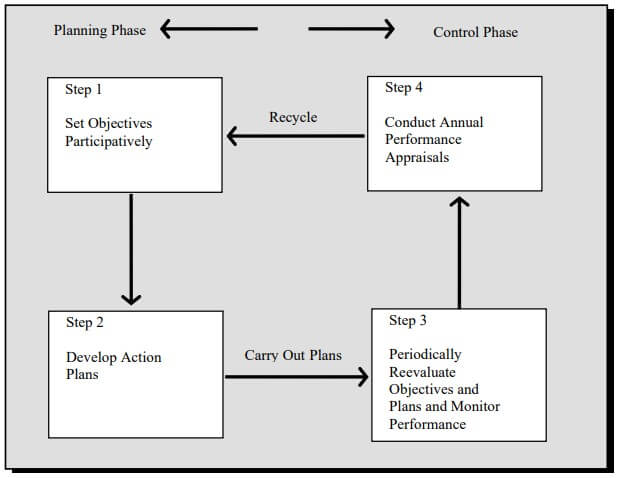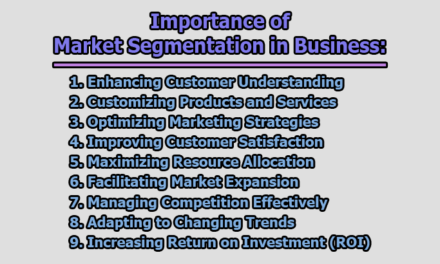The Management by Objectives (MBO) Cycle:
The Management by Objectives (MBO) cycle is a systematic approach to managing and improving organizational performance. It involves four key stages, each of which contributes to goal setting, planning, monitoring, and performance evaluation. Here’s an explanation of each step in the MBO cycle:
Source:Kreitner,,”Management“,Third Edition, P.140
Step 1: Setting Objectives:
Hierarchy of Objectives: The MBO process begins with setting a hierarchy of objectives. Objectives should be challenging yet achievable, fair, and internally consistent. These objectives serve as the foundation for all subsequent actions.
Involvement and Participation: One of the key features of MBO is the emphasis on participation and involvement of subordinates in an objective setting. Rather than a top-down approach, MBO encourages negotiation of objectives between superiors and subordinates on a give-and-take basis.
Documentation: All objectives should be reduced to writing and kept for future reference in steps 3 and 4. This documentation ensures clarity and accountability.
Step 2: Developing Action Plans:
Planning Phase: The second step involves developing action plans based on the objectives established in Step 1. Managers at each level of the organization create plans that align with the objectives.
Complementing Plans: Higher-level managers need to ensure that the plans of their direct subordinates complement each other rather than conflicting. This alignment is crucial for achieving organizational objectives.
Step 3: Periodic Review:
Monitoring Performance: With the action plans in motion, attention shifts to step 3, which involves the periodic review of performance. Regular face-to-face meetings between superiors and subordinates should be held at intervals such as 3, 6, and 9 months.
Validation of Objectives: These periodic check-ups help assess whether the established objectives are still valid or need revision in light of changed circumstances.
Feedback: Periodic reviews also provide an opportunity for managers to give well-considered feedback to subordinates, promoting continuous improvement.
Step 4: Performance Appraisal:
Matching Performance with Objectives: At the end of one complete MBO cycle, typically one year after the goals were set, performance is evaluated in relation to the previously agreed-upon objectives. Superior-subordinate pairs meet again to discuss the outcomes.
Emphasis on Results: MBO places a strong emphasis on results rather than on personalities or excuses. Success is rewarded with promotions, incentive payments, or other suitable benefits, while corrective action is taken in the case of failure.
Behavioral Principles: During performance evaluation in steps 3 and 4, managers should consider principles such as participation, feedback, reciprocated interest, and recognition to motivate employees and promote alignment with organizational goals.
Continuous Improvement and Evolution:
Repetition of the MBO Cycle: The MBO cycle is designed to repeat itself, contributing to the learning process and ongoing improvement. Each cycle builds on the previous one.
Gradual Introduction: MBO is typically introduced at the top of the organization and gradually involves additional layers of management each year. Implementing MBO too quickly can lead to confusion and dissatisfaction.
Evolution of MBO System: It often takes several years, even for a moderate-sized organization, to fully establish an MBO system that integrates areas like planning, control, performance appraisal, and the reward system.
In conclusion, the MBO cycle is a systematic process for setting objectives, developing action plans, monitoring performance, and evaluating results. It emphasizes participation, feedback, and alignment with organizational goals while promoting continuous improvement and motivation among employees.
References:
- Griffin, “Management”, Houghton Mifflin Company, Boston, USA, 1984.
- George R. Terry, Stephen G. Franklin, “Principles of Management”, A.L.T.B.S. Publishers & Distributors, India, Eighth Edition, 1997.
- Heinz Weihrich and Harold Koontz, “Management – A Global Perspective”, Tenth Edition, pp.163-164
- Ibid, pp. 137-142.
- James A.F., R. Edward and Daniel R. Gilbert, Jr., “Management”, Prentice Hall of India Private Limited, Sixth Edition, 1997.
- Kreitner; Management, (Boston: Honghton Mifflin Company), pp. 133-34.

Assistant Teacher at Zinzira Pir Mohammad Pilot School and College










